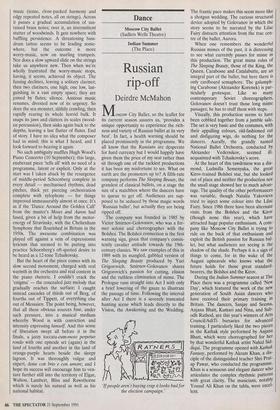Dance
Moscow City Ballet (Sadlers Wells Theatre)
Russian rip-off
Deirdre McMahon
Moscow City Ballet, so the leaflet for its current season assures us, 'provides a unique opportunity to experience the rich- ness and variety of Russian ballet at its very best'. In fact, a health warning should be placed prominently in the programme. We all know that the Russians are desperate for hard currency but I would happily have given them the price of my seat rather than sit through one of the tackiest productions it has been my misfortune to see. What on earth are the promoters up to? A fifth-rate company performs The Sleeping Beauty, the grandest of classical ballets, on a stage the size of a matchbox where the dancers have to queue to get off. Audiences are sup- posed to be seduced by those magic words `Russian ballet', but actually they are being ripped off.
The company was founded in 1985 by Victor Smirnov-Golovanov, who was a for- mer soloist and choreographer with the Bolshoi. The Bolshoi connection is the first warning sign, given that company's consis- tently cavalier attitude towards the 19th- century classics. We saw examples of this in 1989 with its mangled, gabbled version of The Sleeping Beauty produced by Yuri Grigorovich. Smirnov-Golovanov shares Grigorovich's passion for cutting, elision and the ruthless elimination of mime. The Prologue runs straight into Act I with only a brief lowering of the gauze to illustrate the passage of time. Following the interval after Act I there is a severely truncated hunting scene which leads directly to the Vision, the Awakening and the Wedding.
`If people aren't buying crap it looks bad for the election campaign.' The frantic pace makes this seem more like a shotgun wedding. The curious structural device adopted by Golovanov in which the story seems to be narrated by the Lilac Fairy distracts attention from the true cen- tre of the ballet, Aurora.
When one remembers the wonderful Russian mimes of the past, it is distressing to see what currently passes for mime in this production. The great mime roles of The Sleeping Beauty, those of the King, the Queen, Carabosse and Catalabutte, are an integral part of the ballet, but here there is only cardboard semaphore. The galumph- ing Carabosse (Alexander Korenek) is par- ticularly grotesque. Like so many contemporary Soviet choreographers, Golovanov doesn't trust those long mime passages; he has to stuff them with steps.
Visually, this production seems to have been cobbled together from a jumble sale. The set is very basic and the costumes, with their appalling colours, old-fashioned cut and disfiguring wigs, do nothing for the dancers. Aurally, the grandly named National Ballet Orchestra, conducted by Alexander Vedernikov, seemed ill- acquainted with Tchaikovsky's score.
At the heart of this tawdriness was a dia- mond, Ludmilla Semenyaka, the great Kirov-trained Bolshoi star, but she looked out of place and neither the production nor the small stage showed her to much advan- tage. The quality of the other performances was variable, though Natalia Yakovieva tried to inject some colour into the Lilac Fairy. Since 1986 there have been alternate visits from the Bolshoi and the Kirov (though none this year), which have attracted huge popular enthusiasm. A com- pany like Moscow City Ballet is trying to ride on the back of that enthusiasm and exploit the British passion for Russian bal- let, but what audiences are seeing is the shadow of the shade. Perhaps it is a sign of things to come, for in the wake of the August upheavals who knows what the future holds for those great standard- bearers, the Bolshoi and the Kirov.
During the Indian Summer season at The Place there was a programme called 'New Day', which featured the work of the new generation of South Asian dancers who have received their primary training in Britain. The dancers, Sanjay and Seema, Anjana Bhatt, Kumari and Nina, and Sub- odh Rathod, are this year's winners of Arts Council/AdiTi bursaries for advanced training. I particularly liked the two pieces in the Kathak style performed by Anjana Bhatt, which were choreographed for her by that wonderful Kathak artist Nahid Sid- diqui. The programme opened with Kathak Fantasy, performed by Akram Khan, a dis- ciple of the distinguished teacher Shri Prat- ap Pawar, who conducted the programme. Khan is a sensuous and elegant dancer who articulates the complex rhythmic patterns with great clarity. The musicians, notably Yousuf Ali Khan on the tabla, were excel- lent.


























































 Previous page
Previous page